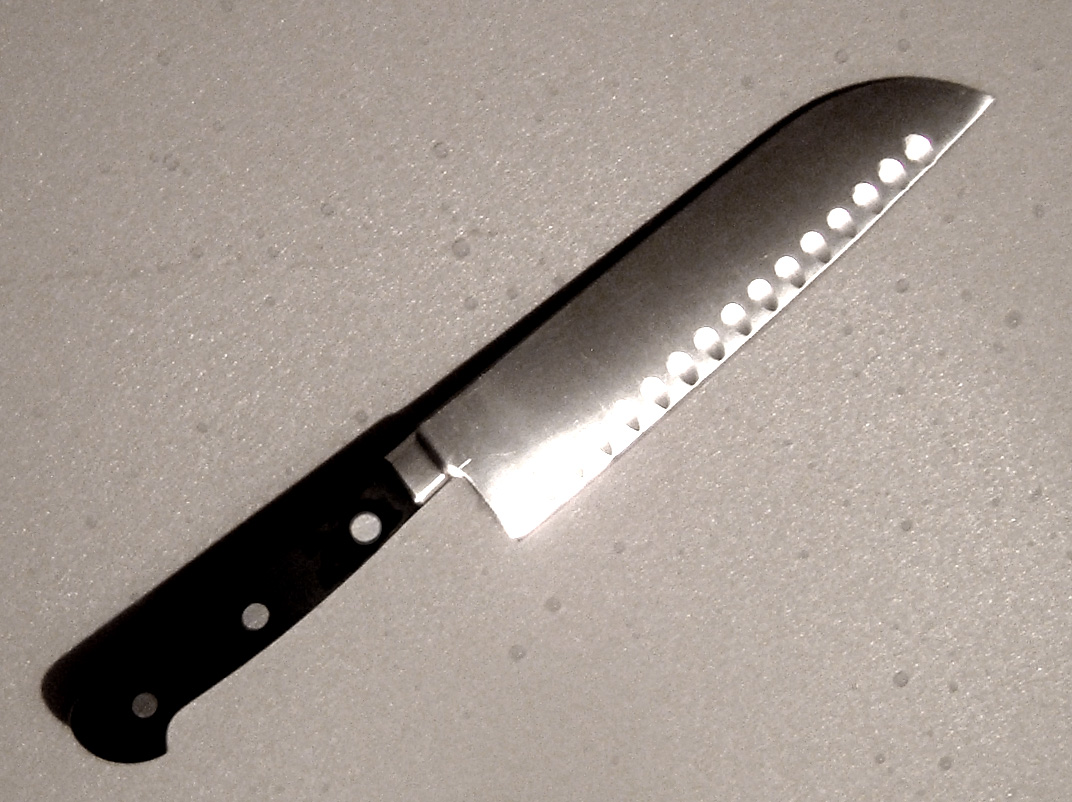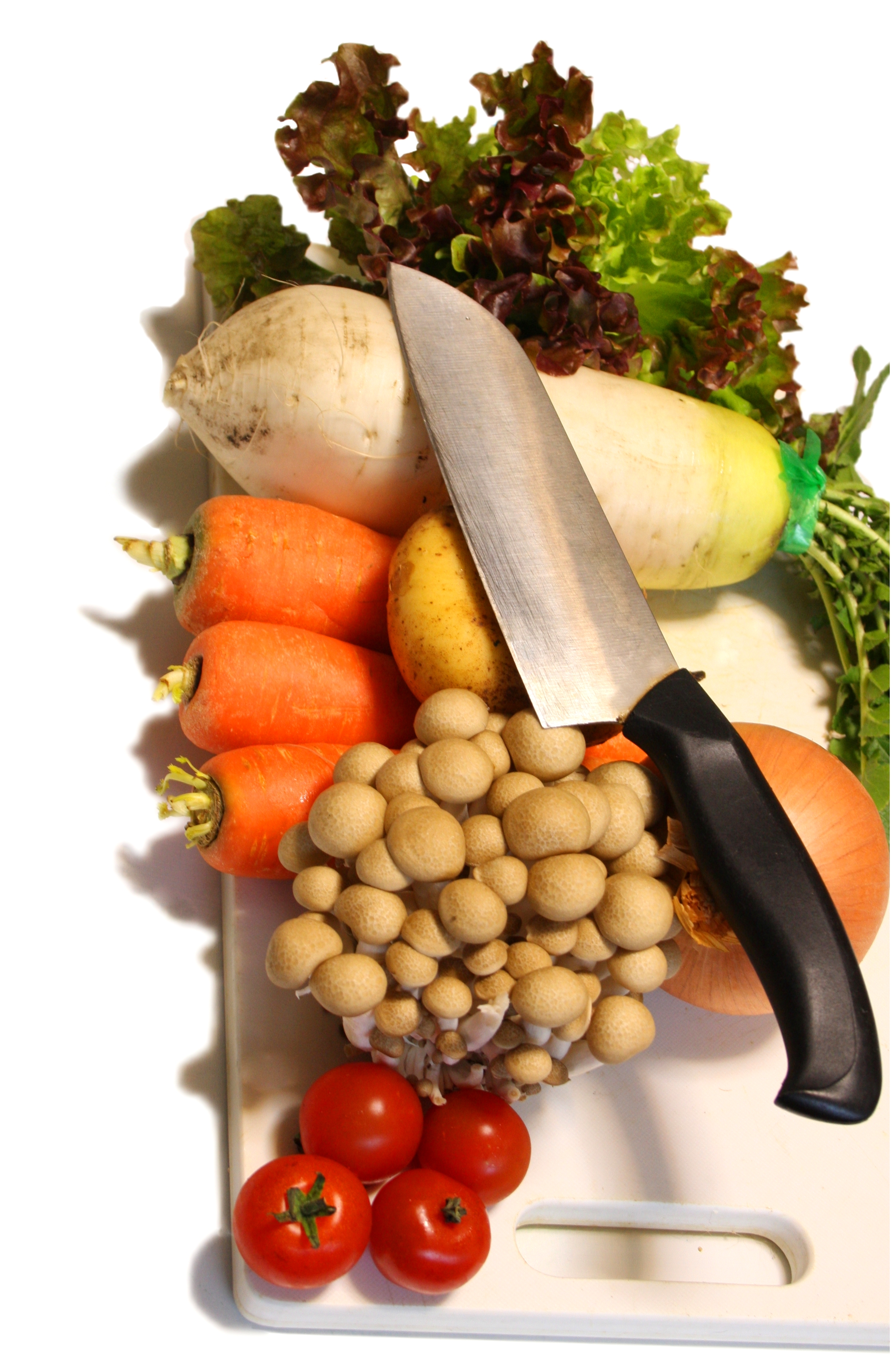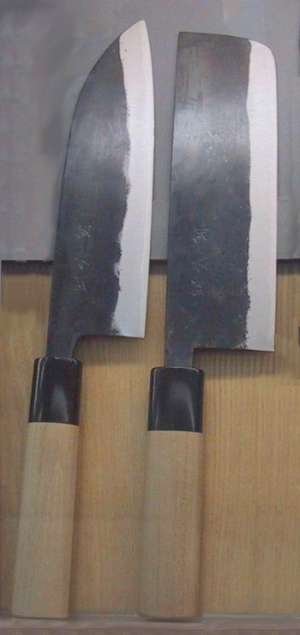|
Usuba Bōchō
''Usuba bōchō'' ( 薄刃包丁, lit. thin knife) is the traditional vegetable knife for the professional Japanese chef. Like other Japanese professional knives, usuba are chisel ground, and have a bevel on the front side, and have a hollow ground urasuki on the back side. Usuba characteristically have a flat edge, with little or no curve, and are tall, to allow knuckle clearance when chopping on a cutting board. Usuba literally means "thin blade" indicating its relative thinness compared to other knives, required for cutting through firm vegetables without cracking them. Due to its height and straight edge, usuba are also used for specialized cuts such as katsuramuki, shaving a vegetable cylinder into a thin sheet. The ''Usuba bōchō'' is used by professionals and differs from the related Nakiri bōchō, which is preferred for home use. While the ''nakiri bōchō's'' cutting blade is sharpened from both sides, the ''usuba bōchō's'' blade is sharpened only from one side, a ... [...More Info...] [...Related Items...] OR: [Wikipedia] [Google] [Baidu] |
:Category:Japanese Words And Phrases ...
{{Commons Words and phrases by language Words Words Words A word is a basic element of language that carries an objective or practical meaning, can be used on its own, and is uninterruptible. Despite the fact that language speakers often have an intuitive grasp of what a word is, there is no consen ... [...More Info...] [...Related Items...] OR: [Wikipedia] [Google] [Baidu] |
Kitchen Knife Indentation
Knife indentation is done away from the edge of a kitchen knife. A knife most simply has either a rectangular or wedge-shaped cross-section (saber grind vs. flat grind), but may also have indentations, whose purpose is to reduce adhesion of the food to the blade. This is widely found in Japanese knives, and in the West is particularly found in meat carving knives, though also in knives for soft cheese, and some use for vegetables. These indentations take several forms: * Granton knives have semi-circular scallops ground into the edge that alternate on either side of the knife and extend from the edge to the middle of the blade. This design was developed and patented in 1928 by Wm. Grant & Sons Ltd A similar design, ''kullenschliff'' (''kulle'' is Swedish for ''hill'' (or -more likely- a misspelling of the German word "Kuhle" meaning "hollow" or "deepening"); ''schliff'' meaning "cut" or ''grind'' in German), has oval scallops (''kuhlen'') hollowed-out of one or both sides of the b ... [...More Info...] [...Related Items...] OR: [Wikipedia] [Google] [Baidu] |
Cutting Board
A cutting board (or chopping board) is a durable board on which to place material for cutting. The kitchen cutting board is commonly used in preparing food; other types exist for cutting raw materials such as leather or plastic. Kitchen cutting boards are often made of wood or plastic and come in various widths and sizes. There are also cutting boards made of glass, steel, or marble, which are easier to clean than wooden or plastic ones such as nylon or corian, but tend to damage knives due to their hardness. Rough cutting edges—such as serrated knives—abrade and damage a cutting surface more rapidly than do smooth cutting implements. Materials A knife edge is a delicate structure and can easily be blunted by a too abrasive surface. Alternatively, it can be chipped if used on a surface that is too hard. A good cutting board material must be soft, easy to clean, and non-abrasive, but not fragile to the point of being destroyed. Hard cutting boards can, however, be used for fo ... [...More Info...] [...Related Items...] OR: [Wikipedia] [Google] [Baidu] |
Nakiri Bōchō
''Nakiri bōchō'' ( 菜切り包丁, translation: knife for cutting greens) and ''usuba bōchō'' ( 薄刃包丁, thin knife) are Japanese-style vegetable knives. They differ from the ''deba bōchō'' in their shape, as they have a straight blade edge suitable for cutting all the way to the cutting board without the need for a horizontal pull or push. These knives are also much thinner. While the ''deba bōchō'' is a heavy blade for easy cutting through thin bones, the blade is not suitable for chopping vegetables, as the thicker blade can break the vegetable slice. The ''nakiri bōchō'' and the ''usuba bōchō'' have a much thinner blade. This does not help with cutting small bones in fish or meat, but is useful for cutting vegetables. ''Nakiri bōchō'' are knives for home use, and sometimes have a black finished, or Kurouchi, blade. The cutting edge is angled from both sides, called '' ryōba'' in Japanese. This makes it easier to cut straight slices. ''Usuba bōchō'' ... [...More Info...] [...Related Items...] OR: [Wikipedia] [Google] [Baidu] |
Deba Bōchō
Deba may refer to: Geography * Deba (crater), a crater on Mars * Deba (river), a river in the Basque Country * Deba, Gipuzkoa, a town in the Basque Country * Deba, Gombe, a town in the Yamaltu/Deba Local Government Area of Gombe State, Nigeria People * Deba Prasad Das (1932–1986), Indian dancer * Deba Gupta (1911–1930), Bengali revolutionary * Deba Wieland Deba Wieland (25 March 1916 – 16 December 1992) was a left-wing German journalist. Between 1952 and 1977 she was in charge at the (East) German News Service (''Allgemeiner Deutscher Nachrichtendienst''). Life Deba Wieland was born at the h ... (1916–1992), German journalist * Bizunesh Deba (born 1987), Ethiopian long-distance runner * Melvine Deba (born 1998), French handballer Other * Deba (moth), a genus of moths of the family Crambidae * Deba bōchō, a Japanese-style kitchen knife See also * Dęba (other) * Deva (other) {{disambiguation, geo, given name, surname ... [...More Info...] [...Related Items...] OR: [Wikipedia] [Google] [Baidu] |
Cleaver (knife)
A cleaver is a large knife that varies in its shape but usually resembles a rectangular-bladed hatchet. It is largely used as a kitchen or butcher knife and is mostly intended for splitting up large pieces of soft bones and slashing through thick pieces of meat. The knife's broad side can also be used for crushing in food preparation (such as garlic) and can also be used to scoop up chopped items. Tools described as cleavers have been in use since the Acheulean period. "Cleaver" was commonly spelled ''clever'' in the late 17th century. Design In contrast to other kitchen knives, the cleaver has an especially tough edge meant to withstand repeated blows directly into thick meat, dense cartilage, bone, and the cutting board below. This resilience is accomplished by using a softer, tougher steel and a thicker blade, because a harder steel or thinner blade might fracture or buckle under hard use. In use, it is swung like a meat tenderizer or hammer the knife's design relies ... [...More Info...] [...Related Items...] OR: [Wikipedia] [Google] [Baidu] |
Kyoto
Kyoto (; Japanese: , ''Kyōto'' ), officially , is the capital city of Kyoto Prefecture in Japan. Located in the Kansai region on the island of Honshu, Kyoto forms a part of the Keihanshin metropolitan area along with Osaka and Kobe. , the city had a population of 1.46 million. The city is the cultural anchor of a substantially larger metropolitan area known as Greater Kyoto, a metropolitan statistical area (MSA) home to a census-estimated 3.8 million people. Kyoto is one of the oldest municipalities in Japan, having been chosen in 794 as the new seat of Japan's imperial court by Emperor Kanmu. The original city, named Heian-kyō, was arranged in accordance with traditional Chinese feng shui following the model of the ancient Chinese capital of Chang'an/Luoyang. The emperors of Japan ruled from Kyoto in the following eleven centuries until 1869. It was the scene of several key events of the Muromachi period, Sengoku period, and the Boshin War, such as the Ōnin War, the Ho ... [...More Info...] [...Related Items...] OR: [Wikipedia] [Google] [Baidu] |
Tokyo
Tokyo (; ja, 東京, , ), officially the Tokyo Metropolis ( ja, 東京都, label=none, ), is the capital and largest city of Japan. Formerly known as Edo, its metropolitan area () is the most populous in the world, with an estimated 37.468 million residents ; the city proper has a population of 13.99 million people. Located at the head of Tokyo Bay, the prefecture forms part of the Kantō region on the central coast of Honshu, Japan's largest island. Tokyo serves as Japan's economic center and is the seat of both the Japanese government and the Emperor of Japan. Originally a fishing village named Edo, the city became politically prominent in 1603, when it became the seat of the Tokugawa shogunate. By the mid-18th century, Edo was one of the most populous cities in the world with a population of over one million people. Following the Meiji Restoration of 1868, the imperial capital in Kyoto was moved to Edo, which was renamed "Tokyo" (). Tokyo was devastate ... [...More Info...] [...Related Items...] OR: [Wikipedia] [Google] [Baidu] |





